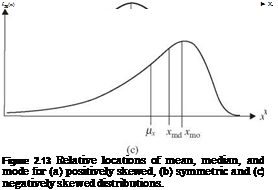Skewness coefficient and kurtosis
The asymmetry of the PDF of a random variable is measured by the skewness coefficient Yx, defined as

|
|
|
|
|
|
|
|

The skewness coefficient is dimensionless and is related to the third-order central moment. The sign of the skewness coefficient indicates the degree of symmetry of the probability distribution function. If yx = 0, the distribution is symmetric about its mean. When yx > 0, the distribution has a long tail to the right, whereas yx < 0 indicates that the distribution has a long tail to the left. Shapes of distribution functions with different values of skewness coefficients and the relative positions of the mean, median, and mode are shown in Fig. 2.13.
Similarly, the degree of asymmetry can be measured by the L-skewness coefficient t3, defined as
тз = A.3/A.2 (2.41)
The value of the L-skewness coefficient for all feasible distribution functions must lie within the interval of [-1, 1] (Hosking, 1986).
Another indicator of the asymmetry is the Pearson skewness coefficient, defined as
![]() l^x xmo
l^x xmo
Y1 =————-
®x
As can be seen, the Pearson skewness coefficient does not require computing the third-order moment. In practice, product-moments higher than the third order are used less because they are unreliable and inaccurate when estimated from a small number of samples. Equations used to compute the sample product – moments are listed in the last column of Table 2.1.
Kurtosis kx is a measure of the peakedness of a distribution. It is related to the fourth-order central moment of a random variable as
with kx > 0. For a random variable having a normal distribution (Sec. 2.6.1), its kurtosis is equal to 3. Sometimes the coefficient of excess, defined as ex = kx — 3, is used. For all feasible distribution functions, the skewness coefficient and kurtosis must satisfy the following inequality relationship (Stuart and Ord,
1987)
![]()
![]() yX + 1 < Kx
yX + 1 < Kx
By the definition of L-moments, the L-kurtosis is defined as
T4 = Л4/Л2
Similarly, the relationship between the L-skewness and L-kurtosis for all feasible probability distribution functions must satisfy (Hosking, 1986)
Royston (1992) conducted an analysis comparing the performance of sample skewness and kurtosis defined by the product-moments and L-moments. Results indicated that the L-skewness and L-kurtosis have clear advantages
over the conventional product-moments in terms of being easy to interpret, fairly robust to outliers, and less unbiased in small samples.






Leave a reply